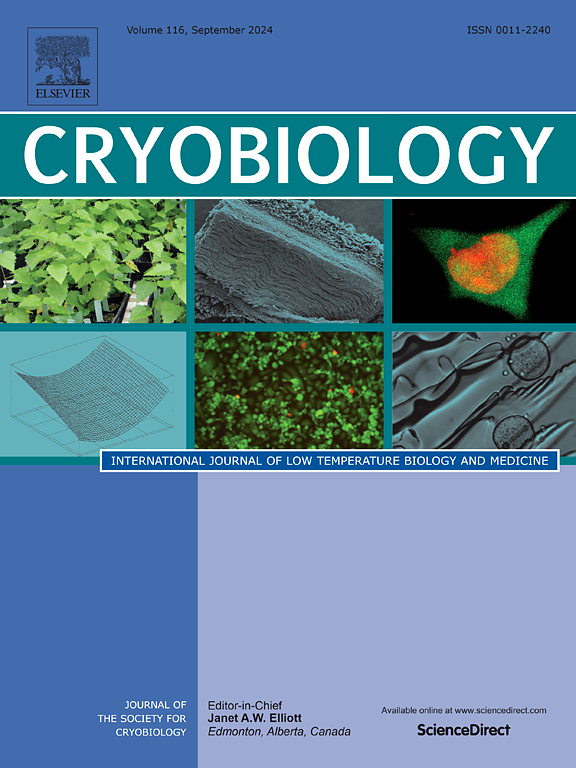Cooling-rate dependence of the cryopreservation of aquaporin-overexpressing cells with a non-permeable cryoprotectant
IF 2.1
3区 生物学
Q2 BIOLOGY
引用次数: 0
Abstract
Dehydration of intracellular water is an important factor in the cryopreservation of cells, but questions remain as to the appropriate amount and timing of dehydration and the detailed mechanism of the freezing process. Answering these questions will lead to improvements in cryopreservation methods that have remained unchanged for more than half a century and to an increase in the number of cell types that can be cryopreserved. Therefore, we aimed to reveal the time point when cells were dehydrated in their cooling process and how much their viabilities were improved by dehydration. We conducted cryopreservation experiments using cells with enhanced water permeability due to membrane overexpression of the water transport channel protein (AQP4). The AQP4-expressing cells or non-AQP4-expressing cells were cryopreserved under different cooling rates after addition of the membrane-permeable cryoprotectant (CPA) Me2SO, the non-membrane-permeable CPA trehalose, or no CPA. The results showed that no cryopreservation was successful without CPAs, even in the AQP4-expressing cells with increased water permeability. At slow freezing rates below 35 °C/min, viability with Me2SO was maintained with decreasing in the cooling rate, but with trehalose, the viability decreased. At cooling rates above 80 °C/min, the viability of AQP4-expressing cells was significantly higher than that of AQP4-non-expressing cells. These results suggest that dehydration due to the osmotic-pressure difference generated after extracellular freezing is fatal to cells.
非透性冷冻保护剂对过表达水通道蛋白的细胞低温保存的冷却速率依赖性
细胞内水分的脱水是细胞低温保存的一个重要因素,但关于脱水的适当量和时间以及冷冻过程的详细机制仍然存在问题。回答这些问题将导致半个多世纪以来一直保持不变的冷冻保存方法的改进,并增加可以冷冻保存的细胞类型的数量。因此,我们的目的是揭示细胞在冷却过程中脱水的时间点,以及脱水对细胞存活率的提高程度。我们利用水转运通道蛋白(AQP4)在细胞膜上过表达而增强透水性的细胞进行了低温保存实验。分别加入透膜保护剂(CPA) Me2SO、不透膜保护剂海藻糖和不加CPA后,以不同的冷却速率对表达aqp4的细胞和不表达aqp4的细胞进行低温保存。结果表明,即使在水透性增加的表达aqp4的细胞中,没有cpa的低温保存也不能成功。在低于35°C/min的缓慢冷冻速率下,随着冷却速率的降低,Me2SO的活性保持不变,而海藻糖的活性下降。在80℃/min以上的冷却速率下,表达aqp4的细胞活力明显高于不表达aqp4的细胞。这些结果表明,由于细胞外冷冻后产生的渗透压差引起的脱水对细胞是致命的。
本文章由计算机程序翻译,如有差异,请以英文原文为准。
求助全文
约1分钟内获得全文
求助全文
来源期刊

Cryobiology
生物-生理学
CiteScore
5.40
自引率
7.40%
发文量
71
审稿时长
56 days
期刊介绍:
Cryobiology: International Journal of Low Temperature Biology and Medicine publishes research articles on all aspects of low temperature biology and medicine.
Research Areas include:
• Cryoprotective additives and their pharmacological actions
• Cryosurgery
• Freeze-drying
• Freezing
• Frost hardiness in plants
• Hibernation
• Hypothermia
• Medical applications of reduced temperature
• Perfusion of organs
• All pertinent methodologies
Cryobiology is the official journal of the Society for Cryobiology.
 求助内容:
求助内容: 应助结果提醒方式:
应助结果提醒方式:


